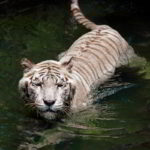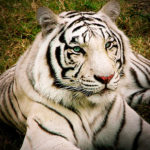Siberian Tigers
 Siberian tigers are widely known to many Russians who are interested in preserving the environment. This beautiful Siberian tiger is photographed simultaneously in the International Red Data Book and in the Red Book of the Russian Federation. Actually, the Siberian tiger is one of the smallest subspecies of the tiger, and its maximum number is today estimated at 530 individuals. Less is only Sumatran tiger (no more than 500 individuals) and South China (almost extinct, about 30 individuals). The extinction of the Siberian tigers is so worrisome for environmentalists that they have repeatedly submitted to the government an appeal for increased protection.
Siberian tigers are widely known to many Russians who are interested in preserving the environment. This beautiful Siberian tiger is photographed simultaneously in the International Red Data Book and in the Red Book of the Russian Federation. Actually, the Siberian tiger is one of the smallest subspecies of the tiger, and its maximum number is today estimated at 530 individuals. Less is only Sumatran tiger (no more than 500 individuals) and South China (almost extinct, about 30 individuals). The extinction of the Siberian tigers is so worrisome for environmentalists that they have repeatedly submitted to the government an appeal for increased protection.
The tiger in general is one of the four species of the Panther genus, to which the largest cats on Earth belong and at the same time are one of the largest terrestrial predators. Tigers are by weight inferior only to white and brown bears.
The bulk of tigers live in warm enough areas – India, Indonesia, China. Tiger Sherkhan became one of the “literary symbols” of India. Unlike the tigers there, their brethren from the Russian Far East live in much more harsh conditions. Low temperatures, strong winds, snow-covered taiga determined characteristic external features that distinguish the Siberian tiger from all other subspecies. First of all, this is wool, which is much thicker for Siberian tigers than for the rest. Its color is lighter than that of Indian and Chinese tigers. In winter, the wool is orange, and the belly is white. Another distinctive feature of the Siberian tiger is a thick (about 5 cm) layer of fat on the stomach, protecting it from the icy wind.
All together – wool and fat layer – create an excellent “armor”, thanks to which Siberian tigers can exist in such extreme conditions. The ears of the Siberian tigers are smaller than those of the rest. This is also due to the cold climate. However, the growth, body length and mass of Siberian tigers are superior to other subspecies.
The weight of the Siberian tiger can reach 200-250 kg, the growth is more than a meter, and the length of the body is three meters or more, not taking into account the tail. Female, as a rule, is somewhat smaller than males. In comparison with the Amur, Chinese and Sumatran tigers seem simply dwarfs – the weight of adult males rarely exceeds 130 kg.



























